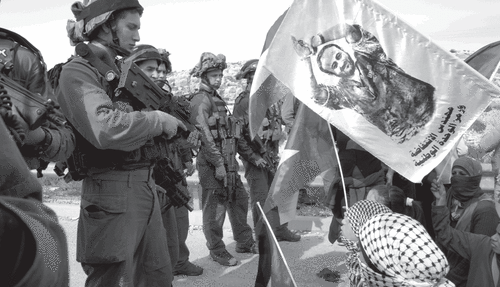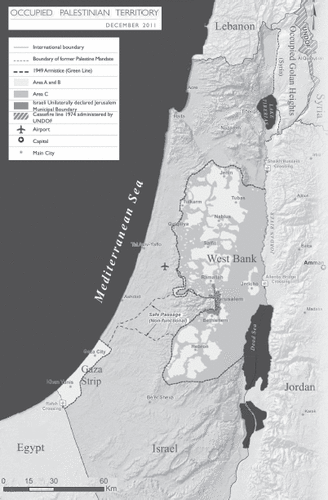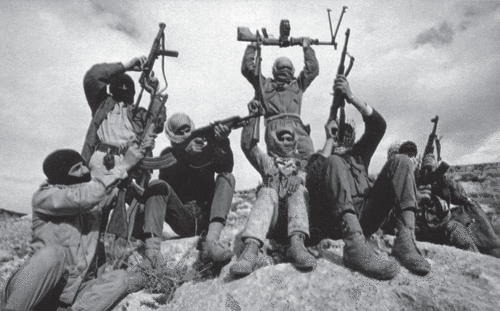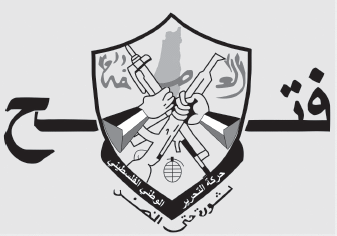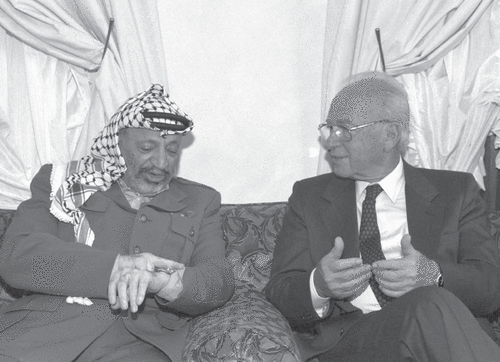The Palestinian national struggle is characterized by political and ideological pluralism. While a diversity of beliefs and perspectives may enrich society and politics, particularly within a democratic framework, when driven by rigidly intolerant ideological dogmas and exclusionary politics, pluralism exacerbates internal tensions and strife.
In the case of the Palestinian national movement, pluralism has historically taken the form of political factionalism, becoming a source of intra-Palestinian rivalries and divisions. This factionalization has weakened the Palestinian body of shared values and dwindled the national and organizational fabric necessary to underpin the movement’s anti-colonial struggle. Furthermore, the Palestinian population has frequently been exposed to international and regional influences. External actors have in many cases shaped intra-Palestinian rivalries, evident in a range of political and ideological issues, wrapped up in self-serving agendas and logics of domination and exclusion. Indeed, factionalism lies at the core of Palestine’s long-standing crisis. This has significantly worsened since the Oslo Accords of the early 1990s, which ultimately led to unprecedented political divisions and ideological disorientation.
Factionalism Before Nakba
alestinians have organized themselves in diverse political forces since the Balfour Declaration of 1917, which proclaimed the Zionist objective to establish a Jewish state in Palestine. Following the collapse of the Ottoman Empire after World War I and its control over Palestine, Palestinian society underwent a period of social transition whereby new classes and modern forms of political organization and ideologies took shape, including communism, socialism, and Pan-Arabism. But by and large the political and ideological landscape remained hostage to traditional social formation, mostly based on hierarchies of kinship, family, and clan.
Under the British Mandate from 1920 to 1948, traditional elites—those originating from urban ‘notable families’ and semi-feudal landlords that typically exercised power over the majority of the population during the Ottoman era—dominated political and economic leadership. Amid the intensity of their struggle against Zionists, traditional Palestinian elites often engaged in intra-familial conflicts to gain authority and power. These elites founded their own political parties, many of which lacked clear ideological and political programs. These parties typically served as vehicles for maintaining personal and clan interests and privileges at the expense of the anti-colonial national cause.
Competing elites and their parties exploited the rising sentiment of anti-Zionist and anti-British colonialism among Palestinians to expand their social power base and fuel internal rivalry. The most troubling social and political polarization resulted from the clannish factionalism between the Husseini and Nashashibi families, notable Jerusalemite families, leading to countrywide factionalist alliances. Both families spent considerable resources to compete with each other, stoking multiple social divides and fragmentations, thereby weakening the national movement’s response to Zionism.
Two approaches dominated the relationship between Palestinian traditional leadership and the British colonial administration. The Husseini family adopted a confrontational approach, which sought to mobilize constituents in struggle against the Zionists and British. While certainly motivated by anti-colonial sentiments, this approach also aimed to protect their social status and authority against the Nashashibis, their political competitors. Meanwhile, the Nashashibi’s al-Difa’ party employed a pragmatic strategy, reflecting a moderate and cooperative stance toward the British colonial administration. Along with other causes, these factional-based internal disunities and rivalries constituted critical factors in weakening the Palestinian political and social fabric before Zionist colonization, which led to the ethnic cleansing of Palestine and the undoing of Palestinian society in the Nakba of 1948. [See Lena Meari’s article in this volume for more on this period].
The PLO’s New Factionalism
The post-Nakba period saw the majority of Palestinians living in deplorable conditions, scattered in refugee camps, and deprived of political rights and dignity. They were also denied a distinct political identity and found their activism subordinated to various Arab regimes and their political parties. By the late 1950s, a few Palestinian resistance groups had emerged and initiated armed struggles along the Israeli borders with Jordan and Lebanon. While these groups lacked organizational structures and resources, they planted the seeds for the formation of the modern Palestinian national movement. In the 1960s, these armed groups coalesced to form a more coherent and organized national liberation movement along diverse ideological lines, collectively constituting the backbone of the Palestinian Liberation Organization (PLO). With support from the regime of Abdul Nasser, Egypt’s nationalist leader from 1956 to 1970, the PLO was founded under the auspices of the Arab League in 1964. Its operations and political maneuvering were both restricted by, and dependent on, the political considerations of Arab regimes.
The Arab-Israeli War of 1967 resulted in the defeat of major Arab states and the colonization of the remaining parts of Palestine, including the West Bank, the Gaza Strip, and East Jerusalem. This defeat inaugurated a new chapter in the development of Palestinian national movement. Post-war regional conditions have encouraged the PLO to prioritize the role of the Palestinian leadership over Arab leadership, independent decision-making, and manpower in determining the fate of struggle.
The broader dynamic of Third World movements, reflected in myriad anti-colonial and anti-imperialist mobilizations prevalent in the Global South—including Latin America—nurtured the post-1967 rise of the PLO. The Algerian Revolution, the Vietnamese resistance, and the Cuban Revolution particularly influenced the modern Palestinian national movement. Yet, with the majority of Palestinians living as refugees in the surrounding countries and beyond, the formation and the expansion of the PLO was mainly centered in exile. This helped parts of the PLO operate transnationally, in collaboration with revolutionary movements such as the Kurdistan Worker’s Party (PKK), the Revolutionary Armed Forces of Colombia (FARC), the German Red Army Faction, and the Japanese Red Army. It also helped sectors of the PLO attract revolutionaries from different parts of the world, including the Venezuelan Ilich Ramírez Sánchez (“Carlos the Jackal”), who was among the most wanted revolutionary figures by the CIA, Israeli, and Western intelligence agencies in the 1970s. Despite Israeli and Western efforts to marginalize the PLO and depict it as a terrorist organization, the PLO successfully brought the Palestinian question to the center of world attention. For example, the PLO was the first national liberation movement to be granted observer status at the UN in 1974, and was internationally recognized as “the sole and legitimate representative of the Palestinian people.”
In the early period of PLO existence (1964-1974), its various factions were relatively unified by a national consensus. This was particularly evident in the PLO’s adoption of a national charter, which advanced a widely accepted strategy of liberation—upholding the creation of a Palestinian state for all of its citizens only after the homeland was liberated from Israel. Despite the PLO’s historic achievements, fragmentary political and ideological agendas limited its power. Factional divisions broke out along multiple issues: modalities of anti-colonial struggle (armed struggle versus civil resistance); international and regional alliances (progressive anti-imperialist states versus reactionary Arab regimes, and how to interact with the U.S.); and distribution of power within the PLO institutions (basing votes on a quota system versus on equal representation). Moreover, competing Arab regimes have exploited the Palestinian political field to promote their own interests, deter and exclude disloyal forces, and in some instances wage proxy wars and counterattacks against other PLO factions on behalf of other regimes’ interests.
The Left’s Divisions and Fatah’s Discontents
The Palestinian Left was the primary victim of sectarian ideological disputes within the PLO, which harmed its cohesiveness and affected its capacity to occupy a leading role within the PLO centers of power. In 1967, various nationalist and leftist groups came together to form the Popular Front for the Liberation of Palestine (PFLP). In its early phase, ideological disagreements led to multiple splits. In 1968, the PFLP-General Command was established as a nationalist organization, operating under the patronage of the Syrian Baathist regime. Another split occurred in 1969 when a group of Maoists formed the Democratic Front for the Liberation of Palestine (DFLP).
Among these leftist movements, the PFLP remained the leading political and military actor. Unlike other Palestinian and Arab communist parties of the era, who adopted Soviet-style Marxism, the PFLP did not perceive adopting internationalist Marxism-Leninism within the framework of progressive Pan-Arabism as contradictory. Its international revolutionary reputation inspired leftist armed struggles and individuals from around the world, who partnered with the PFLP for military training and joint operations.
Meanwhile, the Palestinian National Liberation Movement (Fatah), which dominated the PLO for decades, did not see ideology as a defining feature of its identity and organizational framework. It presented itself as the “custodian” of Palestinian nationalism, but left the concept of nationalism undefined. This ideological ambiguity meant people from a wide range of orientations—ranging from leftist nationalists to center-rightists and conservatives—formed part of the movement. These competing ideological trends never posed an internal threat of defections, though the movement did become vulnerable to external, politically-motivated splits.
Due to changing regional realities produced by the Palestinian-Jordanian military confrontations in 19701971 and the Arab-Israeli War of 1973, the Fatahdominated leadership of the PLO adopted a “10-point program” calling for the establishment of “national authority” over any liberated part of occupied Palestine. The new strategy diverged from the PLO national consensus, which advocated for liberation of the homeland followed by statehood, whereas the 10-point program prioritized statehood over liberation.
In response to Fatah’s adoption of this program in 1974, a group of high-ranking Fatah officials defected and established the Fatah Revolutionary Council. But Iraqi, Syrian, and Libyan regimes coopted this faction, which operated on behalf of their interests. Another major defection occurred in 1983, when a group of radical militants broke off from Fatah over military decisions and the Lebanese Civil War. Fatah’s announcement of its intention to pursue diplomatic relations with the United States did not help matters. With the support of Syria, these militants formed the Fatah al-Intifada faction, which engaged in armed clashes against Fatah forces in Lebanon.
At the heart of the factional disagreements in the Palestinian movement is the long-standing struggle between statehood and liberation. Opponents to this strategy accused Fatah of redefining the PLO original objectives towards more moderate ends, and feared that such a trajectory would ultimately lead to political compromises and concessions to Israel. This debate has divided the Palestinian National Movement between supporters of the 10-point program, led by Fatah, and opponents, led by the PFLP, which asserted its adherence to the PLO’s original objective of liberation. However, changes in the balance of power came to favor the statehood trend. The withdrawal of the PLO from Lebanon in 1982, following an Israeli invasion, weakened liberationist currents within the national movement.
By 1980, the ascendancy of the statehood ambition became readily apparent at the 19th session of the PLO’s Palestine National Council, held in Algeria in November of that year. Yasser Arafat, chairman of the PLO and leader of Fatah, declared the establishment of an “independent Palestinian state,” called for coexistence on the basis of UN resolutions, and condemned “terrorism.” This declaration implicitly recognized Israel and committed the PLO to a two-state solution. After the collapse of USSR and the emergence of the U.S.-led new world order, the PLO officially accepted the two-state formula as the basis of negotiations with Israel with the signing of the Oslo Accords in 1993.
Political Islam and Factionalism
The late emergence of political Islam in Palestine during the 1980s has introduced an additional ideological pillar to the national movement, which has also meant a new factional dimension in Palestinian politics. The introduction of Islamic Jihad to Palestine in the late 1970s, and later the Islamic Resistance Movement (Hamas) in 1987 were turning points in the development of the Palestinian national movement, which saw a surge of anti-colonial Islamic action that simultaneously challenged the historical dominance of secular and nationalist trends. The emergence of Islamic movements in Palestine was a byproduct of the rising significance of political Islam in regional and international politics, which the U.S. and Saudi Arabia initially encouraged to counterbalance socialist movements and Soviet influence in the region. Israel also adopted a similar tactic by tolerating and encouraging the growing religious movements in Palestine to counterweigh the PLO’s influence in the 1980s and especially during the First Palestinian Intifada (1987-1993). Nevertheless, this approach has backfired for Israeli strategists who hoped to manipulate Islamic parties for their interests but ultimately faced powerful challengers.
While both Hamas and Islamic Jihad have been leading vehicles for political Islam in Palestine and represent an Islamic alternative to the PLO’s national secular project, they differ significantly in terms of ideology and politics. Hamas’s ideology is rooted in the school of thought promoted by the Muslim Brotherhood and sees the movement both as anti-colonial and predicated on the Islamic transformation of society by any means necessary as a prerequisite for the liberation of Palestine. Hamas has built up a social reform agenda on the ground through a vibrant network of charitable, cultural, medical, and educational associations that have enhanced its popular base. It has contested the PLO’s status as the “sole legitimate representative of the Palestinian people” and positioned itself as a fierce competitor to the nationalist and leftist forces.
Islamic Jihad, conversely, inspired by the 1979 Islamic Revolution in Iran, is critical of the Muslim Brotherhood’s social reformist doctrine, particularly with regard to the Islamization of society as a prerequisite for liberation. It prioritizes the strategy of armed struggle regardless of society’s beliefs, advocating close cooperation with revolutionary forces. Islamic Jihad has disregarded social mobilization and is mainly focused on political and militant activities. Unlike Hamas, Islamic Jihad has not presented itself as a substitute for the PLO, but rather as a cooperative actor distinguished by its Islamic identity. Furthermore, while Hamas showed a level of pragmatism toward moderate Arab regimes, and Saudi Arabia and other Gulf states have supported the movement for years financially, Islamic Jihad has opposed collaboration with any regime engaged in diplomatic relations with Israel.
Oslo and the Fatal Factionalization of Palestine
The first Oslo agreement, signed in 1993 between the PLO and the Israeli government under U.S. sponsorship, was shaped by the global reconfiguration of power following the demise of the USSR and the subsequent triumph of U.S. capitalism and the internationalization of neoliberalism. The Oslo agreement allowed Fatah leadership to return to the occupied territories and establish a self-governing authority, known as the Palestinian Authority (PA), over limited parts of the West Bank and Gaza. The Oslo agreement employed the framework of a two-state solution, which would be implemented following a series of negotiations throughout a transitional period of five years. However, the Oslo process has not led to conflict resolution or the formation of a Palestinian state, but has rather served to consolidate and deepen Israeli colonial control over the Palestinian life. This is evident in the expansion of Israeli settlements, restrictions on Palestinian movement, fragmentation of Palestinian communities, and Israeli control over the land, resources, borders, trade, and economy.
The PA was established as a state in the making, supported and sustained by Western donors and international financial institutions that played a key role in designing its structures and functions. This has exposed the Palestinian body politic to a variety of interventions and pressures by external actors. Within this context, dominant PLO leadership effectively abandoned anti-colonial struggle in favor of liberal state-building within a context of continuing colonization and military occupation by Israel. One of the most salient political implications of the Oslo process is that it has altered the nature and manifold structures and functions of the Palestinian national movement. Although the PA was supposed to be subordinate to the PLO, it has gradually replaced it as the central reference point of Palestinian politics. Perilously, the establishment of the PA under the domain of Israel’s settler colonial order meant the encapsulation of the wider PLO forces and its political diversity into a narrowly-defined institutional structure, limited and besieged in its geography, and governed by exclusionary politics. This has led to the systematic marginalization of the PLO, which lost its revolutionary capacity and representative mandate through Oslo.
Fatah, in particular, has experienced an indefinite and chaotic transition from a liberation movement to a state party. Yet it is a state party without a state. In effect, the PA is a Fatah-dominated project, built on rentierism guaranteed by international aid, patrimonialism, and authoritarian politics. Fatah leaders dominated PA institutions and exercised autocratic politics lacking representation and legitimate mandates. Fatah cadres became the core of the PA system, represented by a large and inefficient bureaucracy of the public sector, which received a variety of economic privileges in exchange for political allegiance.
Fatah’s former militants were disbanded as part of the PA-Israeli security agreements and replaced by U.S.-trained security forces to perform internal policing to guard the PA elite and safeguard Israeli security. With this transition came a crucial shift in the movement’s political thought and discourse toward negotiations, peacebuilding, state-building, and public order. This served to meet Western donors’ conditions and to satisfy Israeli and American demands, and therefore to maintain the political status quo.
Economically, international donor intervention in designing the overall structure of the PA and promoting neoliberal policies via Israel under the ongoing occupation have fostered patron-client networks, corrupt institutions, and high levels of inequality within Palestinian society. Such conditions have exacerbated internal contradictions and tensions among the different political factions. Unprecedented forms of factionalization and intra-Palestinian divisions have ultimately forced the national movement into a state of political stagnation and ideological disorientation.
The Post-Oslo Left and the Rise of Hamas
The Palestinian left in a post-Oslo environment has faced a dramatic decline, becoming in many ways hostage to the Oslo status quo. The signing of the Oslo Accords came at a critical time for the Left because it followed the disintegration of the socialist bloc along with the demise of world’s revolutionary and liberation movements that were integral allies of the Palestinian left. Politically, the Left was split on the Oslo accords, leading to further fragmentation. This has affected its capacity to form a unified front and produce viable theoretical and practical alternatives to the political and institutional realities of a post-Oslo world.
Ideologically, the Left has also suffered a chronic ideological crisis that has prevented it from reintroducing socialist alternatives and advancing effective liberation strategies. The Palestinian Left has been unable to reinvent new ways of understanding the post-Oslo transformation of class structure and radical shifts in the political economy of the occupied Palestinian territories. Subsequently, the emphasis on social struggle at the core of the Marxist ideas that sparked the Palestinian national movement has largely diminished and become more rhetorical than substantial.
Related to the diminishing of social struggle as a substantive part of the Left’s ideology are the ways that international NGOs have affected grassroots movements in the early 1990s. Civil society has systemically restructured itself according to neoliberal principles as a result of the entry of international donors and the conditions they impose on funding. This process has led many civil society organizations to become elite-oriented rather than grassroots-based, more concerned with implementing donors’ agendas than locally-formulated programs. The effects are ideological changes that depoliticize the nature of struggles and stray from a focus on anti-colonial knowledge and mobilizations. NGO politics have coopted a significant segment of leftist leaders and cadres, who have no effective agenda for radical social change.
Meanwhile, political Islam has become a dominant force at the expense of secular PLO forces. Hamas, in particular, has become a key player in Palestinian politics and has been successful in expanding its popular base. Thus, Hamas has constituted the central challenge to the Fatah-led PA through exercising counter-hegemonic politics outside the PA and PLO structures. In the 1990s, the movement made efforts to delegitimize the Oslo process and PA’s state-building efforts by advocating armed struggle and waging attacks against the Israeli occupation.
Hamas has been successful in positioning itself at the forefront of Palestinian politics for several reasons. First, the movement has used a popular religious discourse that has depicted Hamas as the vanguard of Islam in Palestine. A network of charitable organizations that operated at the grassroots level and among the poorest sectors of the population incorporated this ideological discourse into their work, serving to mobilize a significant segment of the population. Second, Hamas built a coherent internal structure based on strong discipline and organization. Its hierarchy features a sophisticated division between political, military, social, and administrative branches, and between its external and internal leadership. This allowed the movement to maintain an influential presence on the ground even in periods of crisis. Third, Hamas has evolved and developed in an atmosphere dominated by the rise of political Islam in the Arab and Islamic worlds, which ensured various forms of support in a hospitable ideological climate for growth.
A Double-Pronged Policy
Internal contradictions generated by factional rivalry culminated in a civil conflict between Fatah and Hamas in 2007, which ended in bipolar political, social, institutional, and territorial divisions between the West Bank and Gaza. Israel systemically exploited the division by adopting separate policies to the Fatah-led PA in the West Bank—economic peace and security coordination—and the de facto Hamas government in Gaza—a crippling blockade and periodic military assaults, as in 2008, 2012, and 2014. Employing these separate policies has contributed to the institutionalization of an intra-Palestinian divide. This division has engulfed the national movement at multiple levels. On one hand, the Hamas takeover of Gaza meant a compromise between resistance and governance. Once in power, Hamas embarked on a path of de-radicalization to centralize its influence, build bureaucracies and security apparatuses staffed with its members, impose public order, and display careful calculus in external relations. On the other hand, Fatah made further concessions to Israel and international donors, thus improving its ties with Israeli authorities on almost every economic, security, and civil issue. In addition, the Ramallah-based PA has become a major recipient of financial and technical support from Western donors.
Amid this vacuum, the Left has failed to re-emerge as an alternative force to this bipolar division and has instead found itself subordinated to it. Though the Palestinian national movement has left a substantial imprint on the history of the world’s liberation movements, its pluralism has given way to an epidemic of factionalism, which has produced grave divisive effects and led to the movement’s inability to achieve any of its stated objectives.
Additional information
Notes on contributors
Tariq Dana
Tariq Dana is Assistant Professor at the Center for Conflict and Humanitarian Studies at the Doha Institute for Graduate Studies. He was Director of the Center for Development Studies at Birzeit University, Palestine. He is a Policy Adviser for the Palestinian Policy Network (Al-Shabaka), and a member of the steering committee of the International Political Economy Project.

